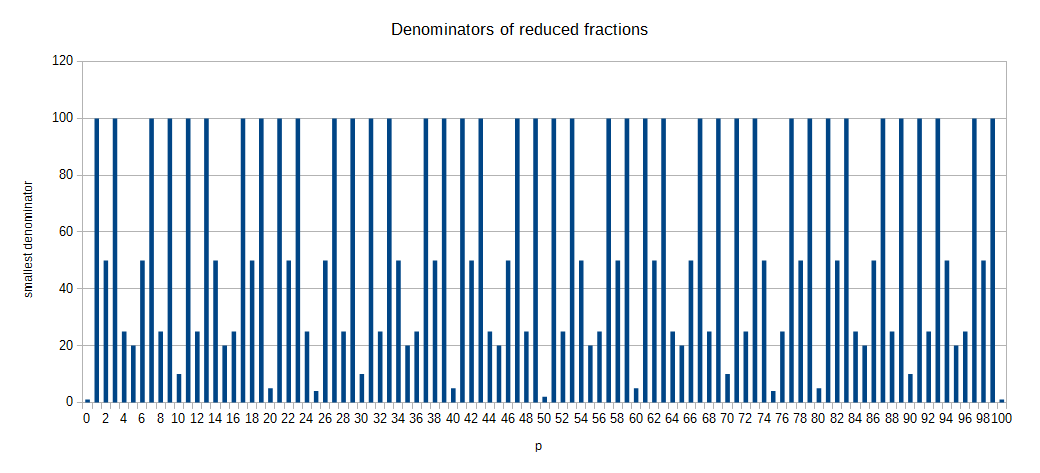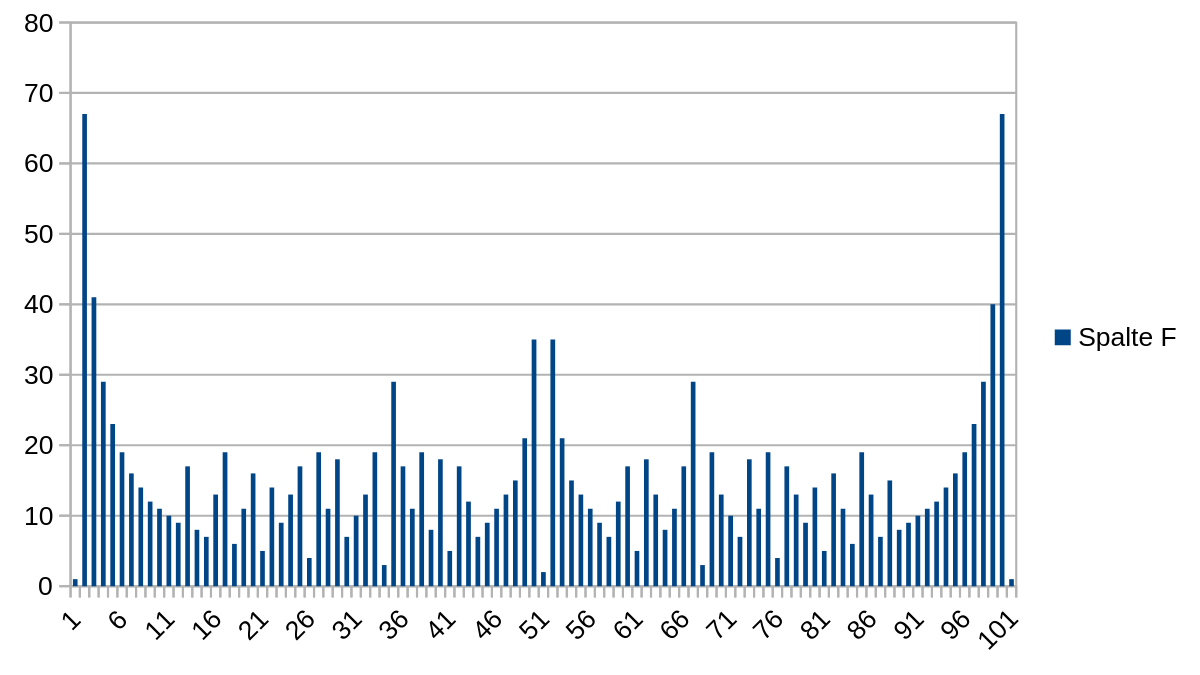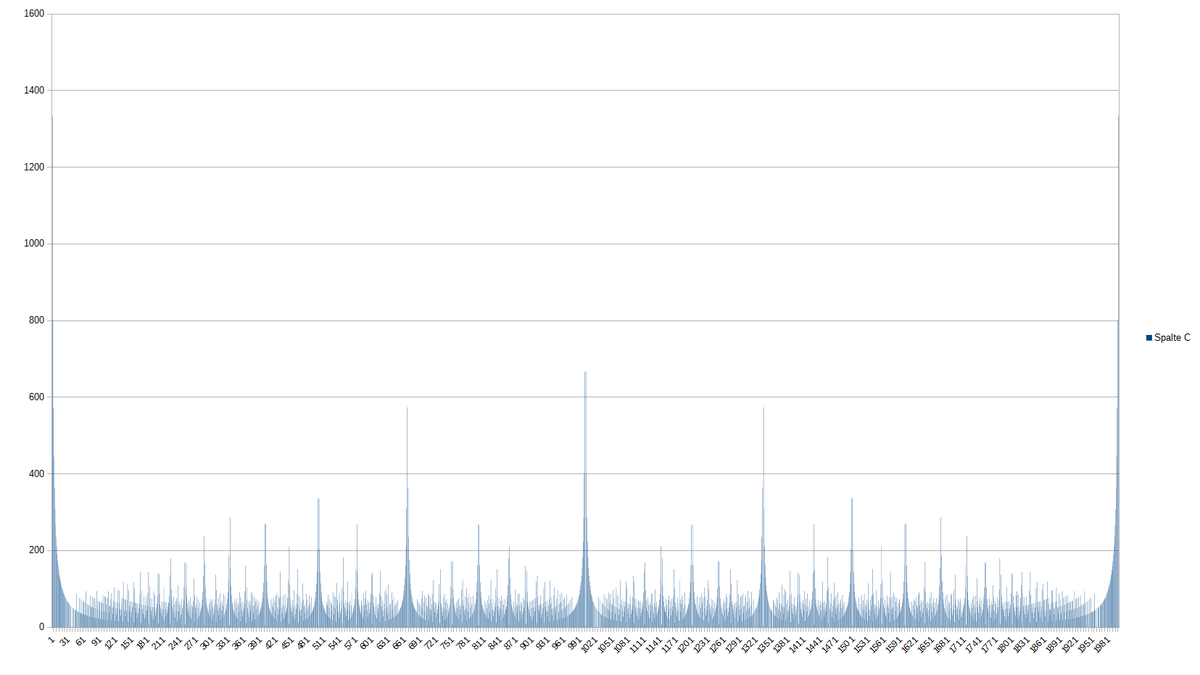Percentages and decimals as rounded fractions
Of course, every possible integer percentage can be expressed as a fraction . Many of these fractions (actually 61, because with Euler's totient function ) can be reduced to have a smaller denominator.

However, if we allow rounding, we can express most percentages with even smaller denominators, e.g. .
Rounding
First of all, we have to define how to round. There are many ways to do this, but we have to conditions that characterize the method we'll use.
- Every number that isn't already an integer (in this case we wouldn't have to round) has two neighbouring integers. Unless the fractional part of , is we can just round to the nearest integer.
- When working with fractions, there is a nice symmetry . This seems trivial, but we definitely want to keep it. So should equal . But when rounded, we get . So, to preserve symmetry, we will always round away from . , but .
These two conditions characterize our rounding method, and we can also write a formula that satisfies both:
The sign-function gives if is nonnegative and otherwise.
If we now want to round with some other precision , we can use the formula
To give another notation, let's define
and in particular
The smallest possible denominator
With these rules in mind, we can now look at the topic of this note – expressing decimals (like percentages) as rounded fractions.
As common, we will only consider reduced fractions; and in this part mainly their denominators.
Let us define a function to give the smallest denominator for which there exists a numerator so that equals when rounded with precision .
Now we can explore some properties of .
If we graph with some fixed precision, say , we see some interesting patterns
 .
.
Every that can be written with a small denominator has neighbours that need very large denominators. For example, , but . This is because for every other , either the fraction could be reduced to exactly or just didn't make small enough steps to hit .
We can make a table of when goes to infinity and is very small, so it's influenced by .
And in general,
Influence
To formalize this influence of simple fractions, let's define a funtion to give the number of values from upward for which is decreasing.
We can look at another diagram of with bigger , in this case ) to see how behaves.

There are all those spikes marking the neighbours of simple fractions, and it somehow looks a little bit like a fractal.
The influence of is easiest to calculate. It can be done with a computer program, but there is no closed formula since it really depends on the value of .
pseudocode:
1 2 3 4 5 6 | |
What we can do, is give an approximation for when gets very large. Since the influence counts the number of -values whose denominators are decreasing, it will stop at the first fraction with a higher denominator, say . But the one before it, , had a smaller denominator and was smaller. So it necessarily also had a smaller numerator, actually because otherwise it could have been replaced by some other fraction with numerator and smaller denominator. From all this we get that the first fraction to interrup the sequence has to have a numerator greater than . This means that there is no fraction with numerator that would get rounded to , so it's too far away from any unit fraction.
We can imagine regions in which all numbers get rounded to the same number as a grid with each cell spanning units.
This is the grid for . Every point marks one unit fraction and will get rounded to the center of the interval it is in. We notice that between and there is an empty interval. This corresponds to the fact that no unit fraction will get rounded to approximately – is too big and too small. So actually, we just have to find the first interval without any unit fractions and then we can calculate .
Finding the empty interval
To find an empty interval, we have to compare the size of the intervals (which is constant and equals ) with the size of the gaps between unit fractions.
The difference between some unit fraction and the next one, is given by
If this gap is greater than , this doesn't imply that the interval is empty. could still be in the interval, in the previous and in the next.
What is sufficient, is that the gap is greater than . A unit fraction could still be in this interval, but either the previous or the next have to leave an empty interval. To find an that satisfies this, we set up the inequality
At first this looks like an upper bound, but actually it is our lower bound for or upper bound for . This is because the inequality gives us a sufficient condition, so there could be smaller poasible values for . We have to remember that and use it later. Now, we also have to find a upper bound for .
If the gap between two unit fractions is less than , the spacing of our intervals, then there has to be a unit fraction in every interval. So we can set up a second inequality
This is also actually an upper bound, because it is a sufficient condition that there is nos empty interval for all values. Ther could be a gap for greater than that.
If we now combine the two, rembering to swap the inequality signs, we find the following conditions for
Somewhere in this region there will be some that works. When gets very large, we can say
and
But, for the influence we care about and we have to multiply by to get the number of influenced s, not the value. So we see, when is large,
Variables and functions I used
Variables
- : temporary variables
- : some index
- : the value we want to express
- : the precision of our rounding
- : the smallest possible denominator
- : the influence
Functions
- : The floor function
- : The sign function
- : the absolute value
Easy Math Editor
This discussion board is a place to discuss our Daily Challenges and the math and science related to those challenges. Explanations are more than just a solution — they should explain the steps and thinking strategies that you used to obtain the solution. Comments should further the discussion of math and science.
When posting on Brilliant:
*italics*or_italics_**bold**or__bold__paragraph 1
paragraph 2
[example link](https://brilliant.org)> This is a quote# I indented these lines # 4 spaces, and now they show # up as a code block. print "hello world"\(...\)or\[...\]to ensure proper formatting.2 \times 32^{34}a_{i-1}\frac{2}{3}\sqrt{2}\sum_{i=1}^3\sin \theta\boxed{123}Comments
Henry, you switched the bracket signs for the links and AWESOME NOTE!!!!
Log in to reply
Thank you!! It's my first note of this kind and I'm glad you like it.
Log in to reply
Actually, if you progress at this rate, YOU ARE A LEGEND!
Log in to reply
Thank you SOO much!!
Log in to reply
You put in so much effort and you dare say that this is your first note! Imagine you are a seasoned note writer! LEGEND!
Does anyone know how to define a function i(p,s) in real code, maybe in Python?
if (p=0) then (i(1/s, s)) else if (1/floor(1/p)>p+1/(2*s) and 1/ceiling(1/p)<=x-1/(2*s)) then p else i(p+1/s, s)